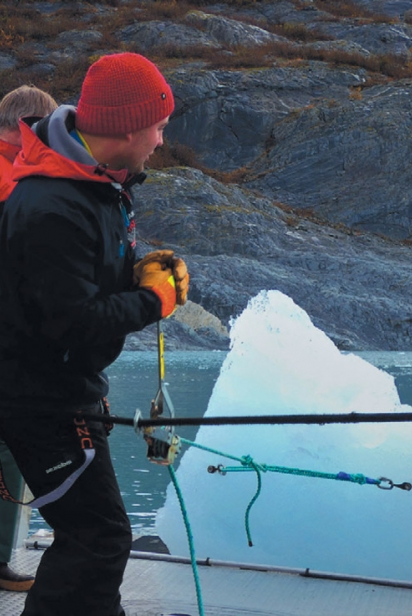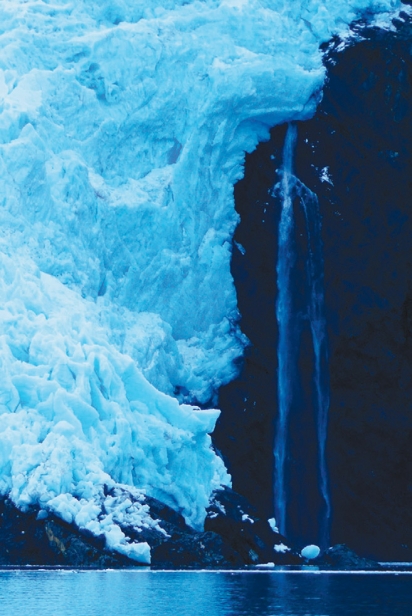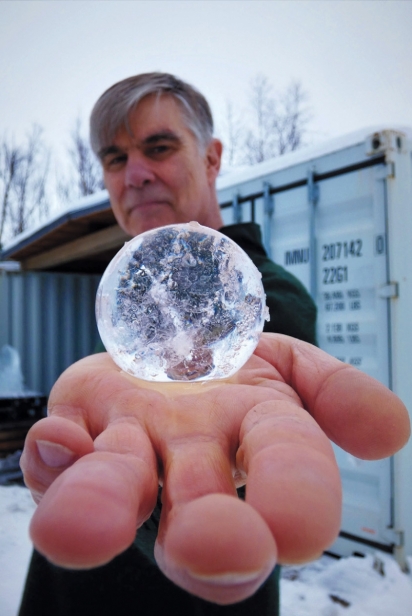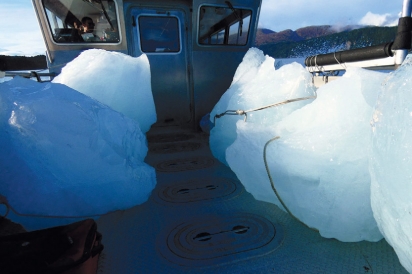Raising A Glass to Alaska's Wild Diminishing Ice
Before refrigeration entered Alaska’s bar scene, glaciers were the local source for ice in The Last Frontier. The wild ice, made of compressed snowflakes amassed over time, provided the only way hard liquor could be served on the rocks until the freezer modernized Alaska’s drinking method with conventional cubes. This improvement made a cold drink easier to come by, but a few things were lost along the way— like the story behind the cube.
Scott Lindquist of Alaska Glacial Ice in Wasilla has spent more than 20 years venturing out into the glaciated landscapes of Prince William Sound to bring Alaska’s glacier ice libation lore into the 21st century’s cocktail bar scene by purveying cubes hand-cut from icebergs. A new partnership between Lindquist and The High Expedition of Talkeetna also promises consumers the chance to taste Alaskan glaciers through a carbonated, organic Nano CBD-infused iceberg water product. Both ventures rely on the tidewater glaciers of Prince William Sound and both have a story to tell through the ice.
On the Water
The 42-foot landing craft left Whittier only an hour ago, but the landscape of Blackstone Bay makes the moment feel prehistoric. A chiseled glacial wall of blue ice is framed by bare rock scraped clean when Blackstone Glacier receded to its current location. Waterfalls drape along the right side of the glacier’s face while seagulls freckle themselves throughout.
The beauty of Blackstone Glacier tempts up-close observation on the boat, but large, bobbing icebergs remind mariners to keep a respectful distance. Known as “rivers of ice,” glaciers are in constant motion even if human eyes cannot pick up their subtle movements. One major calving event can trigger house-sized icebergs to slough off into the sound, displacing enough water to trigger large waves. The captain of Lazy Otter Charters keeps his boat at least one mile away from the face where there is still plenty of ice, but Scott Lindquist knows the freshest icebergs are much closer.
Standing over the side of the landing craft with a hockey stick, Lindquist uses the wooden blade to flip an unassuming bergy bit over. As the voluptuous belly surfaces, we see its scalloped sides, variegated with clear and creamy white divots. He seeks out round icebergs because this shape indicates the berg has constantly adjusted its weight while melting, a motion that expels some of the silt, rock, and wood fragments embedded when Blackstone Glacier slowly excavated the mountains. Air gets trapped inside glacier ice, too.
“As this ice calves off into Prince William Sound and there’s a thousand icebergs all bobbing at the same time, you can hear this incredible ‘snap, crackle, and pop’ sound from all the compressed air being released as the ice melts—it’s like being directly in a bowl of Rice Krispies,” Lindquist said with a chuckle.
This release of compressed air, known as “bergy seltzer,” could have been air trapped since John Muir’s journey with the 1899 Harriman Expedition in Prince William Sound. Muir had a well-known obsession with Alaska’s glaciers, disappearing for days at a time to explore the ancient ice. He also paid his respects by writing about the glaciers, a written devotion that helped spur a tourism industry in Alaska that continues to commoditize glaciers to this day.
In 1911, the bourgeoisie could board the steamship Spokane and spend two weeks vacationing through the “Totem-Pole Route” of the Inside Passage for $100 roundtrip from Seattle (equivalent to $2,650 today). They dined on meals like sauté of kidneys on toast and butter sponge cake between picturesque pit stops en route to Skagway. One of many curated experiences included climbs atop the glacier named after Muir, described by the Pacific Coast Steamship Company brochure as impenetrable: “Rivers may be bridged, valleys may be filled and mountains may be razed to the ground, but Muir Glacier, slow moving monument of time, may only be measured by man as an unconquerable evidence of eternity itself.”
We all know now, this could not be further from the truth.
Photos from the National Snow and Ice Data Center show that between 1892 and 2005, Muir Glacier receded 31 miles. Today, if Muir were to visit the very spot at which he commissioned Thomas Hill to paint Muir Glacier in 1887, there would be nothing to see but gravel, ocean, and mountains in the distance. The National Climate Assessment Report on the Alaska Region highlights Alaska as warming two times faster than anywhere else in the United States.
“It’s just amazing how much ice was there 100 years ago,” Lindquist said. “Edward Harriman was considered the first tourist (in Prince William Sound) and I’m being considered one of the last tourists before [glaciers like Blackstone] completely recede up on land.”
While Lindquist is confident that Blackstone Glacier’s icebergs will still be available throughout his lifetime, a trending market opportunity does not require the bergs to remain frozen.
Onboard the boat to film the iceberg harvest is Joe McAneney, founder and owner of the first cannabis dispensary to open in downtown Talkeetna two years ago and the Alaska lifestyle brand, The High Expedition. McAneney has hired Lindquist to be the company’s iceberg water supplier for an Alaskan product that’s never been bottled before by the beverage industry: Holocene, a carbonated iceberg water product infused with organic Nano CBD oil. Available in 12-ounce cans, Holocene’s flavors include black cherry and raspberry-lime but consumers can also choose unflavored. The high concentration of Nano CBD oil makes the small dose included per can tasteless although McAneney described the concentrated CBD oil itself as earthy and bitter.
By infusing the Nano CBD oil in the iceberg water provided by Lindquist, McAneney attested this will be the purest and most bioavailable product of its kind.
It has been quite the journey, though, to produce Holocene. Murphy’s Law was in full force the first time the company went to can the product at Midnight Sun Brewing Company’s facility.
“We had all the water carbonated, dosed [with Nano CBD], and ready to go in the tank, but when we were sending the water to the canning line, turns out the water was too pure,” McAneney said. “Most canning lines at breweries have fill sensors that have to read some sort of electrical conductivity in the water to know when to stop filling, but the glacier water was so pure, the sensor would overflow the cans.” McAneney had expected 3,500 filled cans by the end of the day, but was left with the expensive product in puddles on the floor.
Fortunately, The High Expedition ethic curated by McAneney is based on the legacy of Alaskan mountaineer Ray “Pirate” Genet, so the challenging obstacles did not discourage the relatively new company. Genet founded the first guiding service on Denali, and had a saying adopted by The High Expedition as the company’s slogan: “To the Summit.” Instead of giving up after the first canning incident, McAneney brainstormed with Midnight Sun’s head brewer Lee Ellis who did something unconventional—he recommended McAneney contact brewmaster Tyler Jones of Broken Tooth Brewery, a competitor whose canning line uses a fill sensor that relies on volume, weight, and time to fill each can.
“There are coffee shops that are selling CBD-infused drinks, there’s SAV-ON Flooring that has signs up saying ‘we sell CBD here,’” Jones said. “Why not a brewery?”
In the beginning of March, Broken Tooth Brewery was able to successfully can the product. The High Expedition has already collaborated with Denali Brewing to feature the beverage in a cocktail called Glacier Shine while the exclusive Sheldon Chalet near the summit of Denali will carry Holocene for their guests. The company has indeed made it to the summit of success with this trending product, but McAneney remains grounded by the company’s two missions: create a brand that proudly features the adventurous spirit of Alaska while educating the public on the cannabis plant and its derivatives. Given the nature of the ingredients, The High Expedition also wants to remind imbibers of the impact climate change is having on wild ice.
“Obviously we’re never really going to be able to mass produce this because of the limited resource that it is,” McAneney said. “Unfortunately we are faced with this crisis of global warming where icebergs are breaking and melting, so we’re trying to incorporate that into our marketing and messaging—like ‘hey, when you drink this product, be cognizant that for you to even drink it, it means we’re messing up the environment. This is a direct byproduct of human actions that are accelerating the warming and melting of our ice caps and glaciers.’”
Glaciers continue to be a poster child for Alaska tourism even if one has to travel further to see them. For years, visitors and Alaskans alike could mush dogs on, helicopter over, kayak to, repel down, and hike on glaciers. A limited few even consumed part of a glacier through Lindquist’s luxury cocktail ice cubes while The High Expedition’s Holocene hopes to increase the accessibility of tasting Alaska’s oldest frozen resource by infusing it with Alaska’s up and coming cannabis ingredient.
With climate change a prevalent conversation starter, consuming the very thing that’s disappearing could be yet another way to remember the legacy left behind when Alaska’s glaciers recede.









